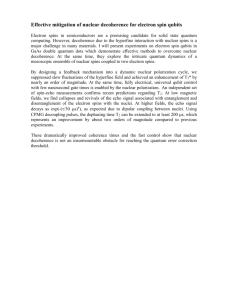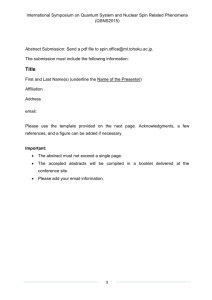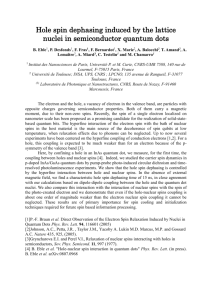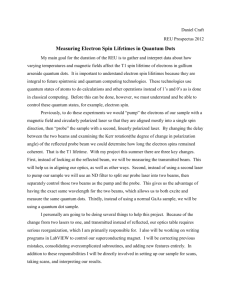Semiclassical limit and long-time asymptotics of the central spin
advertisement
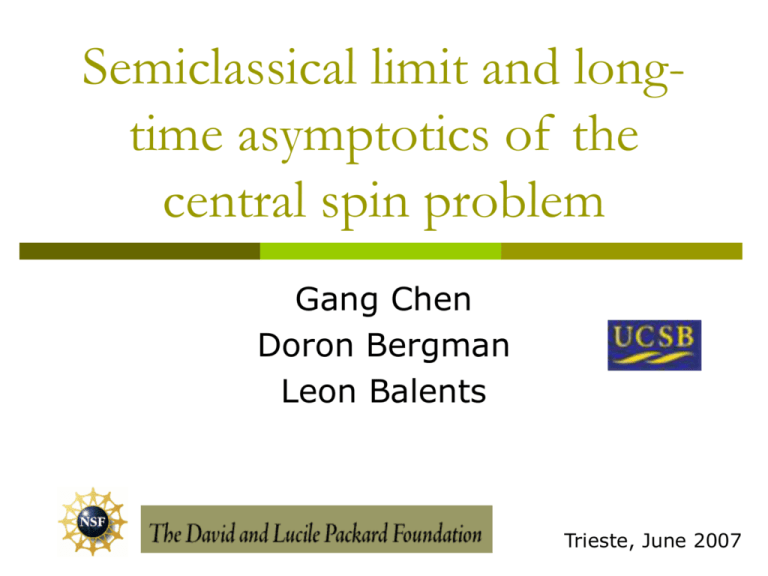
Semiclassical limit and longtime asymptotics of the
central spin problem
Gang Chen
Doron Bergman
Leon Balents
Trieste, June 2007
Outline
The problem
Relating quantum to classical
electron-nuclear interactions in a quantum dot
Experiments and time scales
Quantum versus classical?
Formulation of problem
Self-averaging
Semi-classical limit
Classical dynamics
Short time averaging
Hand-waving argument
Conserved quantities
Infinite time
Numerics
Long-time dynamics
Decay of a single electron spin
Quantum dot spin in single orbital state
No decay from spin-orbit alone
Interacts with:
Kramers degeneracy
Phonons (+ spin-orbit)
Other electrons (can isolate)
Nuclear moments
D. Loss talk yesterday: non-nuclear
mechanisms could be on 1s timescales
Central spin problem
Confined electron couples to all spins in region of
support of wave function
Hyperfine coupling
N 106
Negligible I-I coupling
Equilibrium is trivial
Dynamics is not
tdd 100 s
Typically, very low nuclear polarization
Problem: what is the decay of an initially
polarized electron?
Aspects of the problem
Integrability: “Gaudin magnets”
Different analytic limits
A large class of integrable models
Unified with finite-size BCS (Richardson) model
Formal solution to dynamics recently by Yuzbashyan et
al – not useful so far for central spin problem
Large applied fields, large nuclear polarization, short
times…
Non-exponential/partial relaxation at long times
Numerics
Zero field and polarization
slow logarithmic decay at long times
Saturation at non-zero Sz for small systems
c.f. Greilich talk yesterday
Some Experiments (there are more)
Marcus group (also Kouwenhoven group)
Use double dot
S=0,1
QPC
S=0
Use Pauli blockade:
Adiabatic
to
Initialize:
(0,2)
singlet
Evolve
Try
to transition
viatransport
hyperfine
(1,1)
singlet
interaction
back
to
(2,0) state
Experimental results (Petta et al, 2006)
Measurement of shorttime hyperfine
induced decay
thf 10 ns
Spin echo technique
shows that hyperfine
field is quasi-static
tnuc > 1 s
Time scales
Hyperfine coupling constant, e.g GaAs
ai = 90 eV vunit cell |(ri)|2 90 eV/N.
Hyperfine field: e- frequency
For double-dot experiments, thf 10ns
Typical field on nuclei
In double-dot experiments, tnuc 1-10s
Dipole-dipole “nuclear diffusion” time
tdiff 100s
Focus
of this
talk
Trieste, 2005
Quantum!
Daniel Loss
Classical!
Yuli Nazarov
Quantum formulation and
semiclassical limit
Quantum Formulation
Initial state
Nuclear wavefunction randomly drawn from
appropriate ensemble
Time evolution
Measurement
Question: how much does C(t) depend
upon the initial state?
Some numerical studies
Numerical studies on single non-product
pure initial states give reproducible results!
Schliemann, Khaetskii, Loss
(2002): “Quantum parallelism”
(14 spins)
Al-Hassanieh, Dobrovitski, Dagotta,
Harmon (2006)
(21 spins)
Thermal Ensemble
General nuclear wavefunction
Distribution
In large N limit, equivalent to Gaussian
distribution for C{m}
(infinite
temperature)
Self-Averaging
Mean correlation function
Fluctuations
Exponential convergence!
Semiclassical approximation
Hyperfine field is large
Should behave classically
Electron spin and individual nuclear spins
remain quantum
By Ehrenfest theorem, electron spin expectation value
then obeys classical equation of motion
Can we do a better job of justifying the
classical limit?
What classical quantity corresponds to C(t)?
Path Integral
Trotter formula for electron spin only
separable product
Coherent state representation of TrI:
Ordinary (not
path) integral
Product of N O(1) terms suitable
for saddle point
Saddle Point
Saddle point equations
Natural solution
Then nuclear expectation values obey
And
Remaining integrals:
Average over initial nuclear spin directions
Classical dynamics
Short times: electron precession
Hyperfine field is quasi-static
Averaged over electron
precession time, spin
follows HN
Same as adiabatic quantum evolution
No “flip-flop” processes
Longer times: handwaving
Further e- spin relaxation is due to motion
of nuclei evolution of HN
Occurs on times ait>1: N1/2 longer than thf
Spins with largest aj contribute most
Total angular momentum is conserved
HN decays by transfer of spin out of central
portion of dot
strong spins
dynamical
spins: ajt>1
Remaining spin
(Somewhat) less handwaving
Electron spin is eliminated from equations
of motion
Conserved quantities (Gaudin)
Angular momentum
Energy HN (but not direction
Others
For any q
)
Direction of nuclear field
For finite N, where does hyperfine field
point?
Long-time average? There is only one invariant
vector
(time average)
Can show this provided:
converges to well-defined time average
Clearly requires t>1/gmin
Statistical mechanical approach
Ergodicity assumption: over long times,
system samples all accessible states
The states are constrained by conserved
quantities (fixed by initial conditions)
Clearly, fixing I leads to non-zero HN .
Largest terms in HN are
proportional to those in I
How about the other conserved quantities?
Conserved quantities
A more convenient representation:
Equivalent linear combinations
The set hn, n=0…N-1 form an equivalent set of
variables to Ij.
The conserved quantities:
Progressively
weaker
constraints
on h1 HN
Statistical mechanical results
Constrain p=1,2… conserved quantities:
p=1:
p=2:
Comparison to numerics
Simulate of dynamics to compute
e.g.
p=1 approximation
p=2 approximation
Correlations for
3 profiles
p=1
p=2
Connection to dynamics
Quasi-ergodic assumption:
At time t, subsystem of spins with gjt < k
sample its (constrained) phase space.
n.b. To logarithmic
accuracy, for exponential
g(R), R(t) is
independent of k.
Apply theory for Sz to this subsystem
Synthesis
Synthesis
For fixed initial conditions, we had
for
Adiabatic relation to electron spin:
Average over nuclear initial conditions
• evaluate this at R(t)
Explicit results
General properties
Averages involve convergent sums
Then
For exponential profiles:
Long-time asymptotics are unaffected by
higher corrections
Comparison to classical numerics
Al-Hassanieh et al
Essentially classical dynamics, N=16000
Anisotropic d=3
Lines are c/ln t
=2
Erlingsson+Nazarov
c/ln t
Probably consistent w/theory
Better comparison would be useful
=1
Prospects
Questions
Quantum corrections?
Better treatment of classical dynamics
Needed for dynamics at intermediate times
Extensions:
Non-zero field, non-zero polarization
Nuclear dipolar interaction
Other quantities:
Is there a timescale beyond which quantum and classical
solutions depart? What is it?
Fluctuations and noise
Entanglement
Multiple electrons, e.g. double dot
Comparison to experiment?
